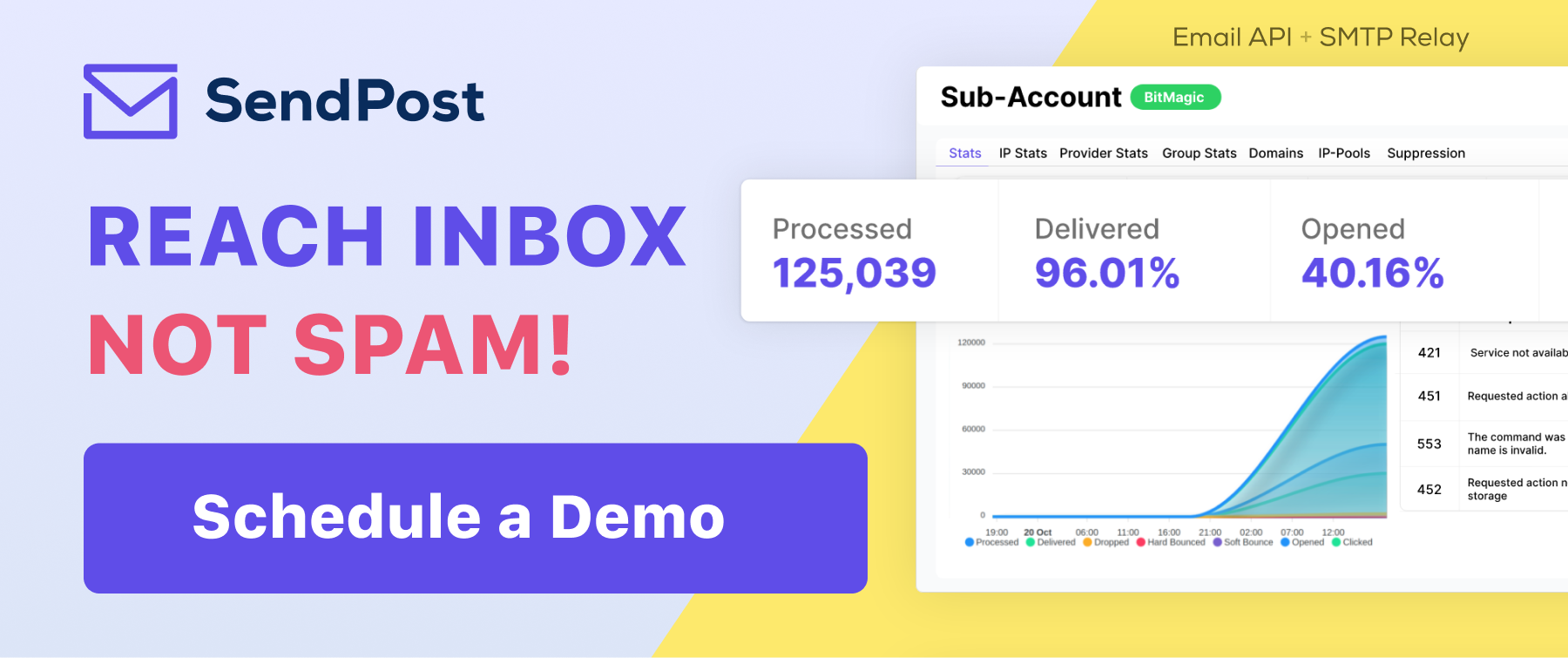SendPost Blog - Email API & SMTP
Email Sender Reputation - How to Improve it?

“A bad email reputation is like a hangover: hard to get rid of, and it hurts everything else.” – Christ Marriott.
So, safe to say that if your email sender reputation is stinking, even engaging email copy, great designs, or the most intriguing subject line might not get you anywhere except the junk folder.
And this serious problem requires you to treat the cause instead of using a band-aid approach.
In this article, we’ll explore what email sender reputation is and how you can recover from a bad one.
What is Email Sender Reputation?
An Internet Service Provider or ISP assigns a score to a business sending emails. It’s just like your credit score that determines your reliability and authenticity.
The score is given on a scale of 0 to 100. The closer you are to 100, the higher your chances are of landing in your subscriber’s inbox. On the other hand, a low score can throw your hard work in the spam or even reject it directly.
But the good news is that the ISPs don’t hand out the email sender score randomly. It’s calculated on some specific metrics, which means you can always work towards improving it.
- IP Reputation: You share information across the internet through IPs. So, to judge your credibility, ISPs monitor the reputation of the IP you are using.
Using shared IPs might seem a cost-effective alternative for a budding business. But sending your emails through it can impact your sender score compared to using a private or dedicated IP. It’s because shared IPs are used by other businesses, and their actions directly affect your sender score.
- Domain Reputation: The next metric in the spotlight is your domain reputation. ISPs also monitor how your domain is used and measure the sender score based on it.
- Content Reputation: The most critical aspect under scrutiny is the content that you are sharing. ISPs also check the copy of your newsletters, emails, and other such mass communication for spammy content or keywords.
- Engagement Level: Ultimately, your recipient’s response to your emails greatly determines your sender score. If a large number of your contacts are marking the emails as spam or are unsubscribing from the list, it raises a red flag for the ISPs to take action.
How to Check Your Sender Score?
The sender score isn’t readily available for you to check. But there are many paid and free tools to analyze the email sender reputation.
Some most popular are:
- Sender Score: It’s an online tool by Return Path that analyzes your IP address and generates a score between 0 to 100 based on your sender reputation.
- Trusted Source: Developed by Mcafee, it gives a complete report of the IP, domain, and URL reputation.
How to Improve & Maintain the Email Sender Reputation?
1. Invest in Dedicated IP
You might be limiting the returns of your email marketing campaigns if you rely on shared IPs to communicate with your contacts.
Shelling out a few bucks for a private or dedicated IP can save you a lot of headaches. Contrary to shared IP, it won’t be affected by the actions of other organizations.
With shared IP, if even one organization is misusing it, the ISPs will flag the IP address, and it will impact the sender score of every other organization using that shared resource.
2. Get the Authentication Right
Since domain reputation weighs heavy while calculating the sender score, it demands special attention.
Before you start shooting emails, configure your email domain for the following authentication processes.
- DKIM: Domain Keys Identified Mail uses a unique key as a digital signature and adds it to the email. This is called the private key. Another copy of the same key is with the mail server so that verification can be done. And this one is called the public key.
When both these keys match, mail servers allow the email to be delivered to the recipient. It ensures that only trusted sources reach the recipient.
- SPF: Sender Policy Framework is an email-authentication process where the mail server maintains a list of approved domains that can send emails on your behalf. It limits the threat of phishing and spoofing.
- DMARC: Domain-based Message Authentication, Reporting, and Conformance or DMARC is an additional layer of security on top of DKIM & SPF. It’s used to validate that DKIM & SPF are correctly implemented. If not, it will reject the email.
3. Build List Hygiene
You can’t expect a good sender reputation if you send messages to any email address you can get your hands on. Because the fact is not every contact, you purchased even exists. That’s why limiting the intrusion of spam addresses from your contact list is a must.
- Use email verification tools like NeverBounce to check if the email address is valid or not.
- Weed out the contacts that have bounced or have been inactive for a long time.
- Don’t send emails to those who have unsubscribed. It’s better to focus on contacts who are genuinely interested in what you have to say.
- Implement double opt-in to ensure that only verified email addresses subscribe to your mailing list.
4. Build List Balance Quality & Quantity
Maintaining the content quality and the right frequency to sustain a healthy relationship with your subscribers is crucial.
- Create engaging email copy that delivers real value to the readers. Check your content for any spammy words like ‘free’, ‘lucky winner’, ‘lottery’, etc.
- Use a ratio of 60 and 40 for text and images in your email. Too much text can overwhelm the reader, while too many images mark your email as spam.
- Provide an option to your subscribers for setting custom preferences. It will allow them to receive only the emails they wish to read.
- Plan the email frequency and stick to it. While you must avoid sending too many emails in a week, ensure that the email quantity is enough to keep you fresh in the reader’s memory.
When you plan your email campaign for dedicated days of the week, the readers also start expecting and anticipating your message. But if you only rely on the burst of inspiration to shoot emails, it can limit the effects or even lead you to spam.
5. Safeguard Email Reputation With Sub-domain
If you are using your domain for email campaigns, the recipient’s response to it will impact your domain reputation too. And if the results aren’t good, it can also hamper your transactional communication.
So, to separate these two, create a sub-domain and dedicate that to your email marketing. The reputation garnered by the sub-domain won’t have any consequences on your parent domain.
6. Warm-up Your IP
Using a new IP is exciting because it has no bad record that can damage your sender reputation.
But before you start launching full-fledged campaigns, pause.
ISPs track the email volume for the IP addresses, and any sudden change in the email traffic can raise red flags. That’s why it’s highly critical to lead your way gradually with the new IPs.
- Start with a small batch of email addresses that are valid and active.
- Send them well-designed emails every week to build a reputation.
- Monitor the sender score for improvements.
- Once the email reputation is stable and healthy, go ahead with sending emails to the rest of your contact list.
7. Conduct Deliverability Audits
Monitoring your email reputation can avoid any surprises and prepares you better for the journey. And email deliverability plays an essential role in determining your overall sender reputation.
Here are some key metrics to look out for:
- Bounce: Ideally, if your list has a bounce rate of more than 5%, you must clean your contact list before the next campaign.
- Open & Click Rate: It gives you a fair idea of whether your contacts are interested in your email or not. You can improve your content reputation based on this metric.
- Unsubscribe: If a lot of your contacts are unsubscribing you, it’s a big red flag for you to reevaluate your email campaign strategy. See if you are targeting the right audience with the right message.
Tracking this data becomes more manageable if you use an ESP to trigger your email campaigns.
8. Implement Sunset Policy
Sunset policy is a simple method to assess your contact list and make it more targeted.
Here’s how you can use it:
- Filter out the least active contacts who haven’t responded to your communication in the last 5-6 months.
- Plan a re-engagement campaign for them that you can send weekly for at least a month. Discounts or offer campaigns work the best in these scenarios.
- If you plan the campaign well, you’ll be surprised to see how many contacts start engaging with your services.
- For the rest, remove them from your list as they are no longer your target audience.
Conclusion
Email reputation demands constant effort to maintain it. It’s not a one-time exercise.
If you are already struggling with a severe sender reputation, then immediately stop your campaigns. Let it cool down for a while before restarting the communication.
Many tools provide a blacklist delisting option too. You can request deleting your IP from this index if it’s not being used for spam. After verification, if the claim is found to be accurate, you can retrieve the sender reputation.
Nonetheless, ensure that your campaigns are done with proper planning, followed by vigilant monitoring.
However, using a little extra set of helping hands never hurts. So, invest in a good email sender & validation tool that backs your effort with the best industry practices. SendPost can be the perfect match for developers, businesses, and ESPs to integrate the APIs and enjoy a better sender reputation with boosted deliverability.








